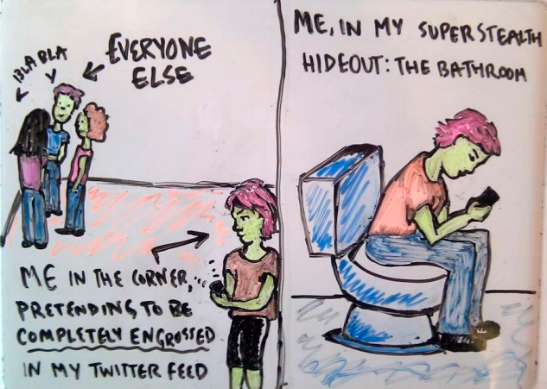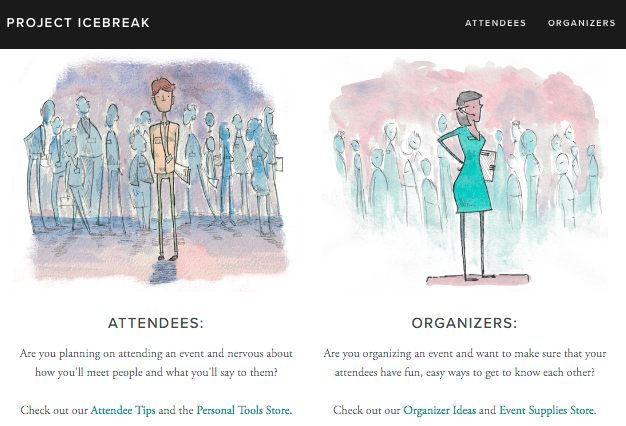
A year ago I found myself wide awake at 5AM after a New Years party with my friends. I was still awake because my mind would not let my body go to sleep — it was convinced that things-were-not-OK and needed fixing, despite my friends all sleeping peacefully around me and the birds chirping outside.
Desperate to get to sleep, I researched insomnia and paranoia on the internet. I discovered a webpage about Generalized Anxiety Disorder and I read it with fascination — it described my mind to the tee, including the kind of physical activities I enjoyed (rock climbing, martial arts). I followed a 10-minute calming technique from that site called
Progressive Relaxation, and I was soon asleep.
That’s when I truly realized that I was an anxious individual. Sure, I’d identified as “stressed out” or “worrywart” in the past, but I figured everyone would be in those situations. But when I could see my anxiety so large next to the calmness of those around me, I realized that my anxiety was something my mind was intent on having, despite it being unneeded.
For the past year, I’ve been studying my mind in detail — trying to understand all of its mental states, to see what techniques can change its mental state, and ultimately, to be able to avoid ever sinking into such a deep pit of anxiety again.
This post is an overview of what I’ve tried, and how it’s worked for me. I am not a psychologist or a scientist. I encourage everyone to investigate their mind for themselves, and I hope my quest can give you ideas.
Getting Away From It All
Just after that New Years party, my partner and I spent a
winter in the woods. We had already planned the trip, with the goal of seeing how different the world and our selves could be. We learned a lot, but as I detailed in
my post on the trip, I found out that my mind could even become anxious during walks along the beach. It was at that point that I actually started an “Operation Calm the Mind Down” spreadsheet — I was determined to figure out my anxiety once and for all, gosh darn it.
Compassion Meditation
When we got back to SF, I immediately signed up for the
Stanford Compassion Cultivation Training course, an 8-week class inspired by Buddhist teachings on compassion for yourself and others. Our only homework was to meditate each day, using a different meditation mp3 each week. At first, I was only meditating every few days, as it felt like a chore that wasn’t producing anything for me.
But then our third week was a self-compassion meditation, and whoah, I could see the effect of those sessions! From then on, I meditated nearly every day. Somehow, the self-compassion script could kick me out of my fast-paced analytical mind into a slower nurturing mind, and affected my approach to the world that day. I didn’t suddenly walk around as a Zen monk, but I could feel my edges soften.
Of course, that meditation may not do the same for you. That’s why I encourage would-be meditators to explore the hundreds of meditation scripts and styles out there. Find out if there’s one that’s Just Right™.
Flotation Tank
A flotation tank, or sensory deprivation tank, is a coffin-like structure with gallons of heavy salt water inside it. Once you go inside, you turn the lights off and float for an hour or two. They are now popular enough that you can find them in cities, like Reboot in SF.
As it turns out, I adore being inside a flotation tank (and my fear of the dark doesn’t follow me in!). I often feel significantly calmer after — and I can see the proof of that in how okay I am with simply wandering around the nearby parks and not rushing off to get back home.
If I had infinite time and money, I might start every day off with a flotation tank session. However, I don’t, so I only go every few weeks or when I feel a particular need for it.
If you’ve never tried it and you have the resources to make it happen, try it out and see what effect it has on you. And then perhaps in the great big beautiful tomorrow, startup offices will all have built-in flotation tanks. :)
Acupuncture
I’ve always been a very Western medicine kind of girl. But, in the quest to calm the mind, I didn’t want to leave any stones unturned. Especially stones that are down the street and oft-recommended.
So I went to
SF Community Acupuncture and asked for treatment focused on anxiety. While I sat there with the needles in, I did various breathing meditations like counting to 10 and feeling the heart. (If I didn’t, then my thoughts would wander, and they’d likely wander into anxious territory… can’t have that!) I enjoyed the session and felt more relaxed after.
For me, acupuncture didn’t have as much of an effect as the flotation tank and has a similar price point, so I opted not to go back for a second session.
Kirtan (Chanting)
Kirtan is a style of call-and-response chanting from the Hindu tradition. As it’s done here, it’s often a circle of people with a few drums and shakers, and they’ll all follow a chant leader. The chanting is melodic and changes tempo, getting faster and slower.
A friend suggested it to me, and I checked it out one morning at
Laughing Lotus SF. When we first started chanting, I found myself distracted by worries about getting the words right. But then, the chanting got so fast that my mind didn’t have a space to worry, and poof, the worries were gone! I felt amazing afterward, almost high — and I found myself being sociable with strangers, a sure sign of an improved mental state.
From then on, I became a regular at each Tuesday/Thursday kirtan session, and I eagerly looked forward to the moments that the chanting would go so fast that it’d kick my anxious thoughts out. (So, yes, I do tend to get a bit anxious waiting for that moment… funny mind!)
Biofeedback Therapy
At this point, I had discovered various techniques to semi-reliably transform my mental state for a few hours up to a day. But I didn’t want to be dependent on flotation tanks and kirtan groups. I wanted a more permanent mental change.
It was time to bring in the big guns: therapy… biofeedback therapy! I had heard of it once, found
one doctor locally who did it, and decided to try one session. First we talked like regular old therapist-client, so he could find out my concerns and goals.
Then, the fun part: he stuck electrodes on my head. The electrodes monitored my brain waves, which got displayed on a screen in front of me, divided into moving graphs of Alpha, Beta, and Theta waves. The waves were then turned into sound — something like an ocean/organ remix — which I listened to with headphones. Then I would hear beeps whenever my Beta and Theta waves went above a certain level. The Alpha waves are more associated with calmness, and Beta more with thoughts, so our goal was for me to be able to raise my Alpha and lower my Beta. For around 30 minutes, I sat there with my eyes closed, listening to the sound of my brain, and noticing the beeps when my brain went higher into thought-y territory. (I’m not a neuroscientist, apologies for inaccuracies/oversimplifications here.)
After that first session, I felt calm, more able to take my time with things. I decided to go for another 12 sessions to see what my mind would learn from the Alpha wave training. It was a mind-opening experience which I could write much more about, but here were my main take-aways:
- I often experienced a nice after-glow from the sessions — similar to the effect of the flotation tank. That after-calmness could last the whole day, or just a few minutes, depending on the happenings of the day.
- I started experiencing moments of “no thought”, where my mind would blank while walking around. I had only a few of those moments, but they were lovely enough that they stuck with me.
- Most importantly: I identified less with my emotions than before. Since I now had the experience of actually watching my mind, I could more easily step back in real life situations and observe my mind as a non-judgmental casual observer. That allowed me to let go of my mind’s reactions more easily.
Anxiety Tracking
Once I started the biofeedback therapy, I started tracking my mental state even more rigorously. I wanted to be able to report to the therapist how the week actually went, and not just base it on the last hour of data. I experimented with various trackers focused on mental health, but then I simply downloaded
Grid Diary and I set up a square each day for “When was I anxious today?” and “When was I calm today?”.
That tracking helped me become much more aware of my own triggers and motivated me to address nagging issues that were burdening my mind.
Tibetan Buddhist Retreat
During the last few weeks of my biofeedback therapy, I started reading a Buddhist-inspired e-book,
Meaningness. Buddhism has many teachings on non-reactivity and on realizing the nebulosity of the self, and those teachings complemented my biofeedback realizations beautifully. Those teachings gave me even more permission to let go of my attachment to my self and to my anxiety.
I saw how my mind was helped by the Buddhist-inspired self-compassion meditation and I wanted to know if going further into Buddhism would help me even more.
So, like a good investigator girl, I went into Buddhism for 4 months.
It was an incredible experience, and I hope to write so much about it in the future. But for now, what I will say is that:
- I came to realize how my anxiety often manifests as excited planning, and to truly recognize the negative consequences of such a seemingly positive mental state.
- I now have a giant toolbox of techniques that I can use to calm my mind, and they are all techniques that require only my mind and body to execute — such as different mantras that can balance my mind and meditations to transform negative emotions.
- I believe my mind is more permanently changed now. I wake up feeling much calmer now, before I even employ any of those techniques. I can take on difficult situations that used to scare me. But I know that the mind is prone to falling back into its habits of self, so I am currently going through life at a very slow pace.
My mind has spent 3 decades learning how to be anxious — it’s very good at it. So I will continue this journey with a vigilant yet delicate watch.
May you all fare well on your own journeys into the mind.
 A year ago I found myself wide awake at 5AM after a New Years party with my friends. I was still awake because my mind would not let my body go to sleep — it was convinced that things-were-not-OK and needed fixing, despite my friends all sleeping peacefully around me and the birds chirping outside.
A year ago I found myself wide awake at 5AM after a New Years party with my friends. I was still awake because my mind would not let my body go to sleep — it was convinced that things-were-not-OK and needed fixing, despite my friends all sleeping peacefully around me and the birds chirping outside.
